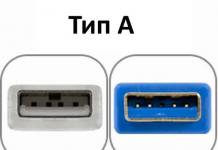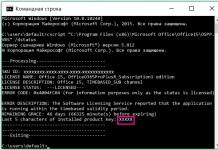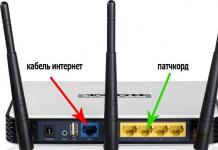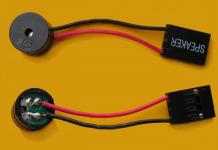If you have lost sound on your computer, then this is of course very bad; you need to figure out why this happened as soon as possible and quickly solve this problem.
The reasons for the sudden absence of sound can be very different, it can be anything at all, so we will look at the 10 most popular reasons. They are suitable for almost any Windows, from xp to 10, including windows 7 and 8.
I will immediately ask you, please take your time before writing in the comments saying what to do, I have no sound on the computer, nothing helps at all. First, consider and work through all 10 steps, I am 99 percent sure that the devil lies in one of the reasons listed.
What to do if there is no sound
Let's start, as usual, with the simpler ones, and end with the more complex ones.
1. Volume controls
Notice the volume icon in the notification area and click on it.

Naturally, the volume slider should be at least in the middle. Make sure it's not at the very bottom.

Well, if the volume icon has a prohibitory icon like this, it means that the sound in the system is completely muted.
Click on it and the sound will appear again.

Here we should also have everything inclusive.

If suddenly one of the sliders is at the very bottom, then move it at least to the middle and then the sound from the speakers will appear.
Don’t forget to check the sound on the speakers, make sure that there are no headphones inserted into them; if they are, then you need to take them out.
And so we continue to look for the answer to the question, Why did the sound disappear on the computer?
You need to go into those devices that are different and check.
Click the volume icon and go to .

In the program that opens, find your speakers in the list of devices and check that there is a green checkmark there.

If God forbid it is not there, then you need to right-click on the device and select Use as default.

If your speakers are highlighted in gray and the status is Disabled then it's easy to fix. Right-click and select turn on, of course Don't forget to make them default.

It also happens that our speakers are not here at all, they are not displayed, in this case you need to click on an empty space and select Show disabled devices. The speakers will then be displayed and they can be turned on as I wrote above, and then set to default.
3. Check your sound card
You need to be sure that the sound card is turned on; if there is still no sound in the speakers, then this point also needs to be checked.

Perhaps it has already been turned on, or maybe it is not here at all, there are different cases if your sound card is not displayed, but there is a section for other devices, for example, audio devices on the bus, and next to it there is a yellow exclamation mark.

This means that the driver has crashed and needs to be reinstalled. I will talk about this in the next paragraph.
4. Check the drivers for sound (Important!)
If you suddenly determine that the sound on your computer has disappeared due to the lack of a driver, then you naturally need to reinstall it.
But for those who have this driver, I still advise you to install it, since most likely the previous version is already outdated and it will be updated with a more recent one.
- First, let's decide which driver we need to download.
- Let's go back to Device Manager and double-click on the sound card.

- Go to the tab intelligence, find the section properties and select an item from the list Equipment ID and several values will appear, we will need the first one first. Copy it.

- Next, go to the website devid.info, enter this value into the search bar and click Search.
- This site will select the most suitable driver for us and we will only have to download the latest version for our operating system.

- After downloading the driver, run the installation file if available.

- If the driver was downloaded in some other format, then it is installed a little differently, you need to use the task manager, click on the Driver tab Update.

- After that, search for drivers using the built-in program.

- Click browse and indicate the path where the driver is located. Click next.

- The installation will be completed and the driver version will be updated upon completion.

But installing a driver for sound is not all.
For those who have a sound card Realtek, and almost everyone has it, I recommend installing an auxiliary program.
It's called RealtekHigh Defender Audio Driver. It helps a lot when working with sound. If, for example, the sound on the computer is lost, then again after installing Realtek High Defender Audio, the problem can most likely be solved.

Download Realtek and install.

The installation takes place in two stages: first, the program copies the necessary files and warns that the computer will reboot, and after the reboot, the driver fully continues its installation.

Once the installation is complete, the computer will need to be restarted again for all the changes to take effect.

As a result, we will see a new icon next to the volume control, this is a small column that indicates that the program is already running.

You can run it and you can even make some settings, but more on that in the next article.

5. Connection to a computer
If the sound still doesn’t work, then here’s another reason that comes up from time to time. Here is his solution.
Unfold the system unit and check that the cable from the speakers is completely inserted into the corresponding connector.

Almost always it is highlighted in green; this is the speaker connector. Check that the cable is firmly inserted into this connector. And in general, to be on the safe side, I advise you to pull it out again and reinsert it again.

6. Windows Audio Service
Sometimes it happens that the sound disappears due to a service failure. Let's check that everything is okay there.

7. Checking the speakers
Of course, you have already checked 100 times, turning the volume controls on the speakers, but I cannot skip this point, since it happens that somewhere the wiring has come loose, they forgot to insert the speakers. Or let’s say the headphones are broken and the like. And the user immediately panics, what to do, there is no sound, what happened.
Connect the speakers that have no sound to another computer or laptop. This will be much more reliable; if you do this procedure, then you will be 100% sure that your speakers are not broken, it will be much easier. The same applies to headphones, if there is no sound there either.
8. Setting up sound in BIOS
This step is for those who have recently made some changes to Bios. If you changed something in Bios, then there is a chance that you accidentally disabled the function that is responsible for sound.

9. Viruses
If you have some kind of hard virus, then it is 100% that it harmed our computer.
You need to remove all malicious programs. Well, of course, the sound rarely disappears due to viruses, but this also happens, so this step also needs to be worked out
10. System recovery or reinstallation of Windows.
If you suddenly lost sound on your computer or laptop, and you even know what day it happened or after what operation, then you can return everything to its place by performing a system rollback.
There is such a cool feature as system recovery. Below are instructions on how to start it.

And in the saddest cases, when system restore did not help or was completely disabled, then reinstalling Windows can help you. This seems to me to be the latest attempt to restore sound on the computer
Nothing helped
I hope you've worked through all 10 steps thoroughly before you get to this point.
But if you have done all this, and nothing helps you, then all that remains is to take the computer to a specialist and let him take a look at you. Most likely your sound card is broken and will need to be replaced.

In any case, I ask you to write in the comments how you managed to solve the sound problem on your computer. Wish you luck.
On modern computers, a very common problem is that the sound on the laptop has disappeared. We’ll look further into what to do if this happens.
In fact, there are not many reasons why this happens. Moreover, they are the same for different laptop models - HP, Lenovo, Acer and others.
So, let's start with the simplest thing.
Settings failed
This problem is that for some reason the sound level is reduced to a minimum or completely turned off.
Moreover, this may not affect the entire system as a whole, but only the browser or system sounds. There are a huge number of reasons for this phenomenon.
The main one is carelessness - the user, due to inattention, can press the volume reduction buttons on his laptop.
On the other hand, this could also be the work of some kind of malicious program, so checking the entire system with an antivirus would be a good idea.
As for solving this problem, everything is done extremely simply. Specifically, you need to do the following:
- In the Quick Launch panel, right-click on the volume icon (highlighted in Figure 1 with a red frame). In the drop-down menu that opens, select “Open Volume Mixer” (highlighted in green).
- After this, the window shown in Figure 2 opens. If we see a muted sound icon there (an example of this is highlighted in a red oval), we need to click on it, after which the sound will return to its normal state.
In general, you need to raise the volume sliders (highlighted with a green frame).

As you can see, the volume mixer window displays all the sounds that are currently in the system. The first column is responsible for almost all sounds that come from the speakers.
The second column is responsible for system sounds. These include the sound of a window closing, error sounds, and the like.
Finally, other bars may appear depending on the programs running.
For example, in Figure 2 there is a column with the Opera browser. It appears only if you watch a video in it or do some other operations in which the presence of sound effects is expected.
In the place where the browser appears in our example, there may be some kind of game or other program currently running.
In general, the first thing to do when audio is missing is to open the mixer, move all the sliders up, and check to see if the audio icons are muted.
Driver failure
As you know, in order for hardware to communicate normally with software, drivers are needed.
They serve as a kind of translator between these two important components of the computer.
Driver update process
To update your sound card driver, you need to do the following:
- Open the Start menu and find “Control Panel” there. Figure No. 3 is relevant for the Windows operating system; in other versions of Windows, this item can also be located in the Start menu, or maybe directly on the desktop or in other places.
In any case, all versions of Windows have a search where we can enter the query “Control Panel” and easily find what we need.

- Here in the search bar you should enter the query “Device Manager” (shown in red frame in Figure 4). You can also find it in the list that opens without any searches.
In the resulting list, you must select “Update device drivers” (underlined in the same figure with a green line).

- This will open the Device Manager. In it you should select the item “Sound, video and gaming devices” (underlined with a red line in Figure No. 5). This is very easy to do - click on the icon for opening a list of such devices (highlighted with a red oval).
Next, a list of all available sound devices will open. By the name you can understand which of them are responsible for the sound - the word “Audio” will appear in the name. Although, to be on the safe side, it is better to update the drivers of all devices presented in this list.
To do this, right-click on each device and select “Update drivers...” (circled in green) from the drop-down menu.

- Now we have two options available to us - automatically searching for drivers on the Internet or independently selecting a driver file. The second option assumes that we have already downloaded the driver for this device in advance or inserted a disk/flash drive with it into the computer.
But in most cases, we still have to look for them on the Internet, so we choose the first option.

After this we will see the process of searching for the required program.

- After this, the system will display a list of available drivers. The user will only have to select one of them by simply clicking on it with the left mouse button. Next, the installation process itself will begin.
Although the system may display a message stating that “the drivers for this device do not need to be updated.” Then you just need to close the open update window and move on to another device.
Disabling the Windows Audio Service
The Windows operating system has such a simple system as Windows Audio. It, in fact, performs a very simple function - providing sound.
In general, there are many similar systems in Windows, and then we will be able to see their entire list.
In any case, Windows Audio may turn off, and the reasons for this are exactly the same as before - carelessness or inexperience of the user, the operation of virus programs, and so on.
This problem can be solved very simply. To do this you need to do the following:
- Press the Win + R key combination on your keyboard to launch the program execution window. In the window that appears, enter “services.msc” and press the Enter key on the keyboard or the “OK” button in the same window (highlighted with a red oval).

- A window for all Windows services opens, including Windows Audio. Actually, we need to find it in all this diversity. Right-click on it and select “Run” from the drop-down menu.

Note: In Figure 9, the “Run” command is inactive, because the serviceWindows Audioworks fine. If there is no sound on the laptop and the “Run” command is inactive, then the problem is not with this service. Otherwise, it will be active and the service can be started.
Sound card turned off
Sometimes a phenomenon may occur that the sound card simply turns off and turns off. And the reasons for this are still the same, but most often it is disabled due to a software glitch.
Without going into details, let's say that the solution to this problem is very simple - enable the sound card in the BIOS. The main difficulty is to enter this same BIOS at all.
The main problem is the different login method on different brands of computers. We will look at how to enter BIOS on different brands of laptops later.
Let's imagine that we have already gotten there. Now you need to understand what to do next.
And after we got into the BIOS, we need to find an item related to sound in one way or another. You can also recognize it by the word “Audio” in the name.
In some cases, the title will include the word “Sound”.
Examples of such names are as follows: Realtek Audio, Audio Controller, Onboard Sound, HDAudio. The latter can be seen in Figure No. 10.

Accordingly, you need to click on this item and select the “Enabled” option. In the above option, this option is already selected, but in the event of a breakdown in the sound card connection, another option will be selected.
That's really all we need to do.
How to get into BIOS
In fact, how to get into the BIOS is already written in the boot screen. You can find an example below.

As you can see, it says that to start the installation you need to press the Delete button on the keyboard. It is also possible to press the F2 button.
In general, all information on this matter can be found in the loading screen.
To get into the BIOS, you need to press the indicated button until it loads into the BIOS.
Now the problem is that, again, depending on the laptop model, the interface can be completely different.
This is what a classic AWARD BIOS looks like. The interface is very old, as it seems at first glance.

This is what the AMI BIOS looks like, which is also quite familiar to many at least somewhat advanced users.

Here is the most advanced interface that UEFI BIOS users can see today. In general, here the creators decided to move away from the canonical forms of AMI and AWARD.

What do we need to find in this most terrible BIOS for many users? Here we need a section that is responsible for the operation of built-in devices.
Again, it will be called differently depending on the model.
Example names: Advanced Features, Chipset or Intergrated Peripherals. In any case, you can understand from the meaning what this section is.
For example, in the same AMI BIOS the corresponding menu item is located where the arrows point in Figure No. 15.

So we need to go there. And there we can already find those menu items that are shown in Figure No. 10.
What to do ellie no sound on laptop on windows 8
What to do if there is no sound on the laptop? - Review of root causes and possible solutions
Imagine this situation: you turn on your computer as usual, but instead of a pleasant shimmering melody, you are greeted only by the hum of a working system unit. No sound on the computer! What to do, why is there no sound on the computer? You, in the silence of your speakers, go online and enter the cherished question: “Why is there no sound on the computer.” This article discusses the main causes and ways to eliminate them. You will find out the answer to your question, namely, step-by-step restoration of sound on your computer.
Here's the question - why is there no sound? And where can I find the answer to this and some instructions?
Why is there no sound on my computer?
The reason for the lack of sound on the computer can only be in the hardware or software environment. That is, you either have faulty components, or you have problems in the settings of the operating system or individual programs. This is independent of the operating system. Similar incidents can happen with Windows XP; sound can disappear in Linux and even in the latest Windows 7 system. Moreover, speakers, headphones and a sound card can be the most modern and expensive.
How to restore sound on a computer?
The first step is to find out the reason for the missing sound on the computer. There are several ways to do this, but you should start with the simplest.
So, sound restoration step by step. Each subsequent step will bring you closer to the result.
1). Try restarting the computer, it is possible that the sound will appear when the operating system starts. This happens.
2). Check that the speaker plug is inserted into the socket. When disconnecting, plug the plug into the socket.
3). Check the switch on the speakers to see if it is turned off. Turn on the sound on the speakers by turning the control clockwise. The LED on the column with the control knob should light up (almost all models have it).

Are the speakers turned on - usually the power light is on on one of them
4). Look at the taskbar and find the speaker icon. It must not be crossed out. If this is the case, then turn on the sound simply by clicking on the “Turn on sound” button.

Desktop sound is muted. Click on the speaker logo
5). Check the speaker level, it can be reduced to a complete minimum - to zero. If the sound is reduced, then simply increase the sliders to the desired level.
6). Check the functionality of the speakers on any sound source. On the player, on the phone, on another computer. The other computer can be a laptop, yours or your friend's.
7). Check Device Manager for unknown devices. This device appears with an exclamation mark. You can open the device manager like this: Start -> Control Panel -> System and Security -> In the “System” column, find the inscription “Device Manager”. All devices there should be identified in this window, there should be no exclamation marks. If there is such an icon, then you need to install sound drivers.

The reason for the sound not working can be found in the task manager
8). Install sound drivers. The sound processor can be built into the motherboard or installed on a separate sound card. Download drivers from the website of the sound card or processor manufacturer.
9). Try inserting a known working sound card into the system unit. You can borrow it from a friend for a while. If the problem is solved in this way, then try the next step or buy a new sound card.
10). Try restoring to a previous restore point in your operating system. In Windows 7, this software environment is located in the “Start -> All Programs -> Accessories -> System Tools -> System Restore” menu.

When the sound disappears, it may be worth restoring the system from a restore point. Suddenly a sound appears.
eleven). Try reinstalling the operating system. And install the sound drivers first, immediately after the drivers for the motherboard chipset. There may be hardware conflicts. If the sound appears, then gradually install the equipment and programs further. The sound may disappear at the most unexpected moment. This could be either a hardware conflict or a software conflict.
12). If nothing helps and sound does not appear on the computer, then the only option is to contact a specialist, or take your computer to a service workshop.
What to do if there is no sound on the computer or the sound is bad?
Before you take action, remember what you did yesterday when the sound on your computer was working. What programs did you install on your computer? Perhaps the problem will be solved if you remove it. Or maybe you deleted some necessary file from your computer. If you haven’t done anything like this, then follow the steps above. Surely something will help you. You can also try using the Help and Support section in the Start menu.

Help and support section - Music and sound, will help you find and eliminate the reason for the lack of sound
If the sound is quiet, wheezing or something else, then try manipulating the software sound settings. Or maybe you just added some kind of effect to the sound, which is why your sound on the computer sounds like it’s coming through a pipe, wheezing and hissing.
If there is no sound only in a certain program, then you need to look at the settings of that particular program. You can also simply reinstall the program, the sound will probably appear.
Don't despair. Everything can be decided, everything is in your hands. Today you can buy a simple sound card quite cheaply and within the reach of any normal person.
Updated: 02/16/2019 Published: 2016 or earlier
Description
- No sound after installing Windows
- No sound
- Sound doesn't work in browser
Cause
- Driver not installed.
- The audio service is disabled.
- Incorrect system settings or system failure.
- Disabled with a special button.
- Incorrect installation of the update.
- Virus.
- Sound card failure.
Solution
The solutions to the problem presented below are arranged in order of frequency of occurrence and ease of implementation. If one method does not work, move on to the next.
1. Before doing anything, just restart your computer - in some cases this will be enough.
2. Right-click on “Computer” (“My Computer”) - “Manage”

* in Windows 10 or 8, right-click on Start - Computer Management.
go to the "Device Manager" section
check that there are no yellow warning signs. The subsection “Sound, video and gaming devices” should contain your audio playback device.
3. Click “Start” - “Run” (or win + R combination) - enter the command services.msc- "OK"

In the window that opens, find the “Windows Audio” service. Its status should be "Running". If this is not the case, double-click on the service, set the startup type to “Automatic”, click “Apply” and start the service;
4. If the sound is gone, check the functionality of the speakers or headphones, as well as the wiring. Check the tightness of the speaker or headphone plug. Try connecting other speakers or headphones to the computer;
5. The speaker icon in the lower right corner of the screen should not have a red prohibition sign:
otherwise, click on it and in the drop-down window click on the prohibiting icon;
6. Install or update codecs, for example, K-Lite Codec Pack or VLC media player;
7. Go to “Control Panel” - “Sounds”. Make sure the correct default audio device is set;
8. If your keyboard has a mute key (most often on laptops), try using it. It is usually located in the area of the F1 - F12 buttons. To press it, sometimes you need to use a combination with the Fn key.
9. Try playing with the sound utility settings. It is installed with the sound card driver and launched from the control panel (“Start” - “Control Panel”) or the system tray (icon in the lower right corner);
10. In some cases, checking your computer for viruses helps. To do this, you can use any antivirus utility, for example, CureIt.
11. If the system reports “The device is being used by another application,” try disabling one application from startup and restarting the computer. If sound appears, turn on programs other than the one that is causing the conflict.
12. If the sound disappears after the computer exits sleep mode, turn off the headphones or speakers - put it back into sleep mode - connect the headphones or speakers - turn it on.
13. If the computer is additionally connected to the TV via HDMI, make sure that the regular monitor and not the TV is active - otherwise the sound may be transmitted to the TV rather than the speakers. You can switch the screen using the Win + P key combination.
14. If the sound worked before, try performing a system rollback.
15. Use the Windows Error Troubleshooter. Click on the sound icon in the lower right corner - Troubleshoot audio problems. Follow the error resolution options that the system offers.
16. If you use monitor speakers, you must turn on the sound in the settings of the monitor itself.
17. It is possible that the sound malfunction may be associated with a broken sound card. To check this, you can buy an inexpensive USB sound card (about 400 rubles) and connect it to your computer (don't forget to install the driver for it).
18. If the methods described above did not help solve the problem, the only option left is to reinstall the system. It's not the most elegant method, but if all else fails, it's the way to go. After reinstalling the operating system, do not forget to install the sound driver.
The most common reason for no sound is turning it off or setting the volume to minimum. If there is no audio playing on your computer, hover over the speaker icon in the tray (right corner of the taskbar). The tooltip will indicate the current volume value. If the sound does not play in a separate application, check its settings. If it is enabled in the settings, audio playback in a specific program may be limited in the mixer. To check, right-click on the speaker icon and select “Open Volume Mixer.” There you can turn on the sound and adjust the volume level for each program running on the computer.
Check the volume on the playback devices themselves: headphones or speakers. When using speakers, also make sure they are connected to power and the power button is in the active position. Checking speakers or headphones is quite easy. To do this, just connect any other device to the audio output instead of a computer: a smartphone, a player.
Important! Also check your speaker settings. To do this, go to “Playback devices”, and in the context menu of speakers or headphones, click “Properties”.
Incorrect operation of audio drivers
Another common reason why there may be no sound on a computer is missing or damaged audio drivers. To identify this issue, hover over the audio icon in the tray. If the message “No audio output device is installed” appears, the problem is caused by the audio drivers.

To resolve these difficulties, right-click on the same icon and select “Detect sound problems” from the context menu.

This will open a troubleshooting window. Wait while the audio diagnostics run on your computer. Depending on the speed of the device, the process can take from a few seconds to a couple of minutes. If the determination of the cause of the malfunction stops at one place, click “Cancel”.

When the sound diagnostics are completed, the system will offer you a choice on which device you want to troubleshoot. In this case, you need to note the device used based not on its type, but on the location of the audio input. For example, if your speakers are connected through the audio input on the front of your computer, check the second box even though it says headphones.

If there is a hardware fault, the diagnostic result will be the following window. It may indicate damage to the speakers or headphones, but most often the cause of difficulties in the operation of audio devices is broken or damaged connecting cables.

At the last step of sound diagnostics, the result of its execution will be displayed. If the problems are resolved, close the troubleshooter. If the diagnostics did not help, click “View additional options.” You can also find help information about the causes of malfunctions by clicking on the “View additional information” link.

Incorrect connection or installation of the device
Sound may not work due to improper connection or installation of audio devices. To resolve this issue, check that the correct input is selected to connect your device to your computer. Speakers or headphones may be connected to the microphone input, causing them to not work.
Go to “Control Panel -> Device Manager” and check the status in the “Sound, Game and Video Devices” menu. If a yellow mark with an exclamation mark is displayed next to the name, the cause of the problem is incorrect installation or malfunction of the device

Note! If your audio hardware is not showing up in the manager at all, update the configuration in the Actions menu.
Right-click on your audio hardware and select Properties, then go to the Driver tab in the window that opens. To update the configuration, click the "Update" button. Here you can remove the driver to reinstall it later.

In the next step, select where you want to search for sound drivers. Two options are offered: automatic search, which includes a search on your computer and the Internet, as well as a simple search for drivers. It is recommended to select the first option to detect drivers.

Important! If the sound card is outdated and its driver is on a separate disk, first copy it to your computer.
The scanning will take about 20-30 seconds, after which a message will be displayed in the search window indicating the successful installation of new audio drivers. If the device already has the latest available driver installed, the configuration will not be updated.

If updating the drivers did not bring the desired result and the device still does not work, it is recommended to remove it from the system. To do this, right-click on the name and select “Delete”. Confirm the deletion in the dialog box by clicking "OK".

After this, you need to update the list of equipment in the “Action” menu. A search will be performed for devices connected to the computer. If the desired device does not appear after searching, restart the manager.

When the speakers are found, their installation will begin automatically. This process may take several minutes. When finished, a message will be displayed indicating that the speakers have been successfully connected and are ready to use.

Damage to connecting cables
Standard 3.5 mm connectors can fail as a result of mechanical damage. Typically, failure occurs at the base of the connector - at the junction with the audio cable. The break may also be in the cord itself. The cause of damage is most often pinched by furniture (table legs, chair wheels). The cable can also be chewed by pets. You can diagnose a breakdown visually or by connecting another cable to the speakers.

Physical breakdown of audio equipment
There may be no sound on your computer if the speakers or headphones you are using fail. This is not difficult to determine - just connect another audio device to the same audio input. If it works, the reason is the broken speakers, and not the computer settings.

Windows Audio Service Disabled
Another common reason for no sound is that the Windows Audio service is disabled. This background process is responsible for processing audio data and is always running by default on a running computer. But if you make changes to the system settings, the Windows Audio settings may be incorrect. The service can also be disabled by malware.


























